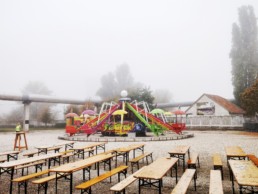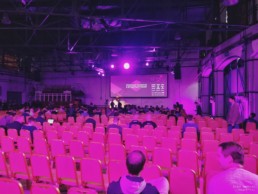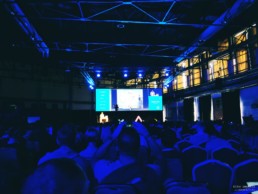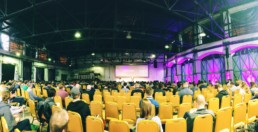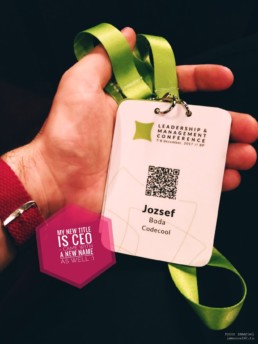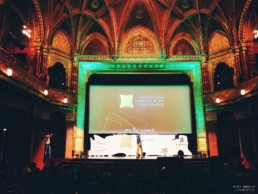Have you ever been to the Crunch or the Stretch Conference? First is about data, the other is about leadership. Here are my experiences and review of both.
It has been quite a busy end of the year, I have done a lot of things and been to many places in just a couple of weeks. This post is about the two conferences I attended at this time, maybe you can get some inspiration towards participating next year.
At first, I will talk about Crunch as this was earlier, and then Stretch from which I expected the most.
Crunch
As I had been mentoring in Codecool’s first BI Developer specialization module, we received some discounts on tickets for Crunch, so I quickly applied. Do you remember me writing we have a so-called educational budget in my previous post? 😉 Crunch is a use case heavy two-day conference for people interested in building the most excellent data-driven businesses. Speakers arrive mainly from abroad from such high profile companies as Linkedin, Netflix, Etsy, Airbnb, Google and many others. As I was the data-mentor, it was an obvious choice to go there and get involved in the topic.
The conference was held in the Hungarian Railway Museum. At first read, I could not imagine how they can organize it at such place as I have been there in this summer and could not remember any building suitable for a high volume gathering. It turned out that they used the old stokehole where steam-powered locomotives were stored and repaired once. The structure is forming a large C letter with a vast rotary-wing in the center. Crunch took place in the upper arm of the C with a large hall and a smaller secondary room separated by thick sound blocking textiles. The middle part was the exhibition area for partner companies, and also breakfast and lunch were served here. The bottom part of the C letter was for another conference held at the same time as Crunch. Amuse is the leading yearly event for all UX/UI designers in Hungary.
While you buy your ticket for one of the two events, you can join both conferences with the same pass, and there is no limitation on going back and forth any time of the day. The badge you receive at the registration holds the map of the venue, some coupons from the sponsors and the schedule of both conferences, so this is by design. Data people can learn some UX design and designers can update their knowledge about database technologies if they are curious. I also joined some Amuse presentations, and I must admit that these are the ones I can recall the easiest as these were not about data (haha) and so stood out from the crowd. Here we arrive at my key takeaways about Crunch (and Amuse).
I like working with data pretty much, but after two days of intense input on the topic, I could fell asleep on the Nth platform design of the Mth company. I understand that real data engineers can get excited to hear about any cutting-edge solutions in the industry, but it seems that I am more versatile with project management and mentoring experience primarily. I also found these presentations exciting at first, but then it became too much. However, there were some talks about data visualization or management related data stuff that I found refreshing along the day filled with low latency, highly cost-effective, easily scalable, etc. solutions.
Even though the slides are always shared after the event, I recommend you regularly to take pictures of the parts you find the most attractive or essential; it is easier to remember to the presentations after a couple of months. For example, there was a lady from Google who gave a lecture about machine learning like we were at the university, she put up all the equations and definitions to the projector, it was remarkably enchanting.
Or there was this intern girl, Zareen from Wayfair, who talked about learning Python and data science on her own and getting a mentor, then a job. She shared some advice to other people at the beginning of their careers how to get better and also to managers about how to create an environment that supports growth. It was great to see that we have been teaching these techniques (e.g., rubber ducking) and providing such environment to our students at Codecool! 🙂
The most memorable moment of Amuse, for me from the presentations I saw, was about how to take better notes on the fly while holding a meeting or listening to a lecture. The lady shared her thoughts in a live demonstration, she took notes about what she said, and we could follow the process through a webcam above her hand. The result was very artistic, and her suggestions seemed to be undoubtedly usable in everyday life.
The whole conference was broadcasted live, and recordings are available on Ustream for both Crunch and Amuse. Tickets are expensive even with some discounts, so if you or your company cannot afford it, you can watch it online. Furthermore, all the presentations are in English every year, so these combined are good news for our fellow mentors abroad if they are interested. You only miss the networking, the merchandising stuff from the sponsors and the food but you can also skip the parts you do not find appealing. Besides, Crunch had two stages, and even there was the Amuse part, so you can only choose one presentation from three parallel ones. The building is enormous, there is time while you go to another stage, you have to find good seats there, and so on. While being online, you can just click on another feed. Unfortunately, heating was not equally distributed in the large indoor area, one part was cold as outside, the other was hot as if it was summer, and the air was continually moving by the ventilation, so I got cold and missed a week from work after that.
Sponsors of the conference got tremendous exposure along the two days, many people contacted them, and they were most likely developers and designers. I got the idea that we should also buy into the sponsorship, many of the interested people could be potential future Codecool mentors, and we could show ourselves to the crowd, many do not even know that we exist and we are hiring. The sponsors delegated at least two employees but I also saw more at some places, and many of them joined the presentations as well, so money may be better spent this way than buying individual tickets.
The price/value ratio is not bad but not that good either. As all the contents are available live and afterward, I think it is better watched online. The quality of the event is high, and I was satisfied with what I got. However, I am also happy that I did not spend my own money on the ticket (around 300 USD). 🙂 I only attended the conference part, and there were several workshops the day before, these might worth their price more. If you would like to go, I recommend not going alone. It is fun if you can share the experience with a colleague, though you can always find old and new friends there.
Stretch
Now, this conference is what I can wholeheartedly recommend to management-oriented people and mentors. I felt myself home both days. Ticket prices are the highest here (around 500 USD as I saw a week before, and this might not include VAT), and their numbers are limited per company to let a diverse audience join and influence a broader spectrum of organizations.
Stretch is a leadership and management conference, this year it was about all different aspects of change. The same group organizes it as Crunch, so the quality of the speakers and the venue are the same, or even higher as they rent the whole Uránia Film Theater every year, and it is a beautiful historic place, excellent choice. Catering and everything were perfectly organized, but even with the limited number of tickets, there were so many people that you always bumped into somebody else physically. As the topic interests managers and company owners primarily, you can meet several interesting and relevant people, so networking is on a whole new level here.
Our management got two tickets, but they could not come this year, and I had been longing to attend for a couple of years, so I was given the opportunity to use one (many thanks, Józsi). This is the story of how I became a CEO for the first time in written history and my nom the plume became József Boda 🙂 Of course I told everyone whom I talked that I am a mentor in incognito, but it was fun nonetheless. None of our internal coaches or other mentors had time to come with the other ticket, so I was there alone again. Never mind, I found my buddies through the days and had several conversations with agile transformers, cryptocurrency users and ambassadors, old colleagues, family acquaintances, Codecool partner company members, and so on. However, I must tell again that conferences are more fun when others are with you, too.
I heard that the presentations were more interesting last year, but no comparisons could be made for me since I was here for the first time. Also did not know that the event is recorded and made available online after some time, I could have seen all of the previous ones since then. Anyways, liked it very much and if next year I happen not to come, I will surely stay two days at home and watch it live, never miss it again. This conference is like playing 45 minutes long TED videos all day in the leadership and organization development category, entertaining and inspiring at the same time. Even if you do not know at first how to use some new information, you can remember back then when you finally need it.
As for the given talks, I would rather not provide a comprehensive summary as you can watch all of them but I do have some notes that may stir up your interest.
If you represent events as dots, and you have N dots, you can draw L links among them, where L=N*(N-1)/2. If there is the starting event as the cause, and the last event as the effect, the possible drawable patterns among events are P and P=2^L. If N=4, then L=6 (possible ways of connecting 4 dots), but P=64 as you can create 64 patterns from links between 4 dots. When N=10, L=45, but P=~35.000.000.000. If you look back and try to understand old happenings, you can not deduce the future from them, a lot many things can still go wrong, hindsight does not lead to foresight.
Halácsy Péter (HP) from Prezi held a presentation about growth mindset, the leading theory from the current models of how people can change. We teach this concept in Codecool, and I was thinking the whole time that “man, we should be up there.” 🙂 If you are not familiar with the growth mindset, watch this video or HP’s talk.
There was a talk about the Organoco method, but I found it mostly promotional than a practical framework that you could implement from tomorrow. The concept is mainly built on coaching, and fortunately, we already have an internal coach, so I see no action items here for us.
A humorous presentation showed us how the army handles pride and criticism. They have a rule to everything, even a seven pages long brochure how to tie your shoelaces. Then we were introduced to the Spotify method, how they organized their development teams and why it is not advisable to copy them as every environment is different. They have a supporting structure where upper-management supports the lower levels, and they introduce ideas from bottom-up. (Just as we do in Codecool:P)
We know for a long time that we have some IQ (Intellectual Quotient). Lately, we see that we have EQ (Emotional Quotient), but now we were introduced to PQ & CQ (Passion and Curiosity) and that their relationship is PQ+CQ > IQ. This equation means that if you are passionate and curious, you may achieve more than those who have higher IQ naturally. The leaders of the future will be the ones who are the “most human” beings.
Curiosity = open mind, compassion = open heart, courage = open will, while fear, cynicism, judgment = you are closed, and it leads towards being absent and disconnected. By the way, positive discrimination is when you do not have an as diverse team as you could have and so you can not think of every possible aspect. An example is a team, who built an infrared operated soap dispenser. Black people could not use it as their skin reflected less light back to the machine than white hands. If a black guy were there, he could test it for the team before production. This talk was funnier than the one I said earlier; the guy is a born entertainer.
Two presentations were about psychological safety which was a commonly used buzzword through the days. Psychological safety is not comfort, does not describe the lack of tension, does not describe a team that likes each other, is not defined by the fun-factor, is not harmony, is not workplace safety. Psychological safety is a belief that one will not be punished or humiliated for speaking up with ideas, questions, concerns or mistakes. Team members feel safe to take risks and be vulnerable in front of each other. Safety is the number one indicator of effective teams. Impacts of psychological safety can be observed on the individual level (more engagement, feelings of vitality thus more creativity, speaking up / voice heard, promoting learning) and on the organizational level (process innovation and organizational performance, high-quality relationships and social capital, organizational learning). Inequality in turn-taking can warn us that somebody is not feeling psychologically safe (e.g., at a stand-up meeting). 10 minutes = 1 + 5 + 3 + 1 and also 10 = 2 + 3 + 2.5 + 2.5 and both have 2.5 minutes mean time but the standard deviation are 1.658 and 0.354 respectively. The smaller SD means more the team members feel safe psychologically (no dominating, no submissive member, etc.).
Small quick notes from other talks:
- Change the question from “how much will this cost” to “how much will it worth.”
- Ownership, collaboration, and learning, these are the mindset domain of business agility, all organized around the customer.
- Steps of efficient culture transfer: build from the bottom up, empower everyone to contribute, change it up, track it then change it up again, share it with the tool the most people use in the company (e.g., Gitlab among developers).
- Create a shared repository of the lessons learned. Let everyone know what was done and how, then learn from it. If you fail, fail smart.
- Somebody showed us a random strategy generator for new businesses. Refresh the page to get a new strategy, hilarious.
If I said Crunch is an alternative place to find new mentors in case of sponsorship, then Stretch is a place to find new business partners.
—
That is it, my review of Crunch and Stretch ends here. Congratulations to you if you have reached this point by reading the whole article, I hope you acquired valuable information about the events. We both deserve a red heart for this achievement, click it below, then share the love in social media.
